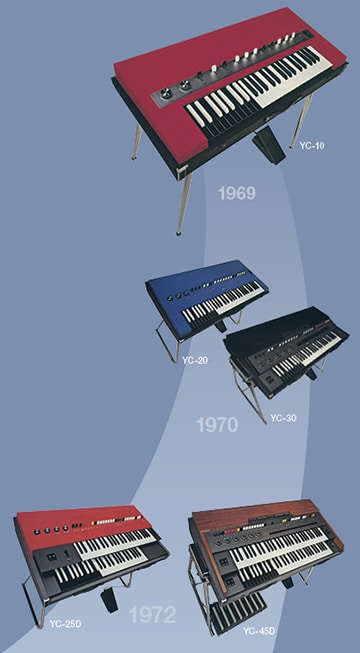YC Series
- Home
- 40th Anniversary Model
- History
- Chronology
- Product Lineup
- News
- Artist Comments
Combo Organs that Strove to be More Expressive

Five years before introducing the SY-1, we released the YC series of combo organs for band musicians. In contrast to our Electones, which featured upper, lower, and foot keyboards that allowed a single player to perform as an entire ensemble, combo organs such as the single-keyboard YC-10 attracted considerable attention as a new type of highly portable instrument.
In terms of both concept and technology, the combo organs of the YC Series have had a major effect on the development of modern synthesizers. The sixties saw the kind of music played by bands such as The Beatles and The Rolling Stones become extremely popular all over the world, producing a shift in demand from organs installed permanently in churches and public facilities to highly portable organs for stage use. With its single 49-key keyboard, four color variations, and a compact design that fit neatly inside a hard, suitcase-type cover, the YC-10 was truly a next-generation organ. It also differed markedly from the Electone in that its sound was output via a separately sold guitar or bass amplifier.
A later addition to the YC lineup, the dual-keyboard YC-45D was capable of changing sounds instantaneously—functionality achieved through the addition of a large number of tone levers, as well as preset levers. Adopting a similar approach to the subsequent CS-80, these components offered a glimpse into the future of the synthesizer.
The YC-45D was packed with many other novel functions that narrowed the gap with the latest synthesizers—for example, keys could be wiggled left and right to produce a touch vibrato effect, while a ribbon controller provided for smooth pitch bending. Looking back, one cannot but admire how far the developers pushed the expressivity of the keyboard instrument.
Although no further additions were made to the YC Series after the YC-45D, the desire to make keyboard instruments highly expressive—which lay at the heart of their development—carried over into the SY-1 and subsequent Yamaha synthesizers.
